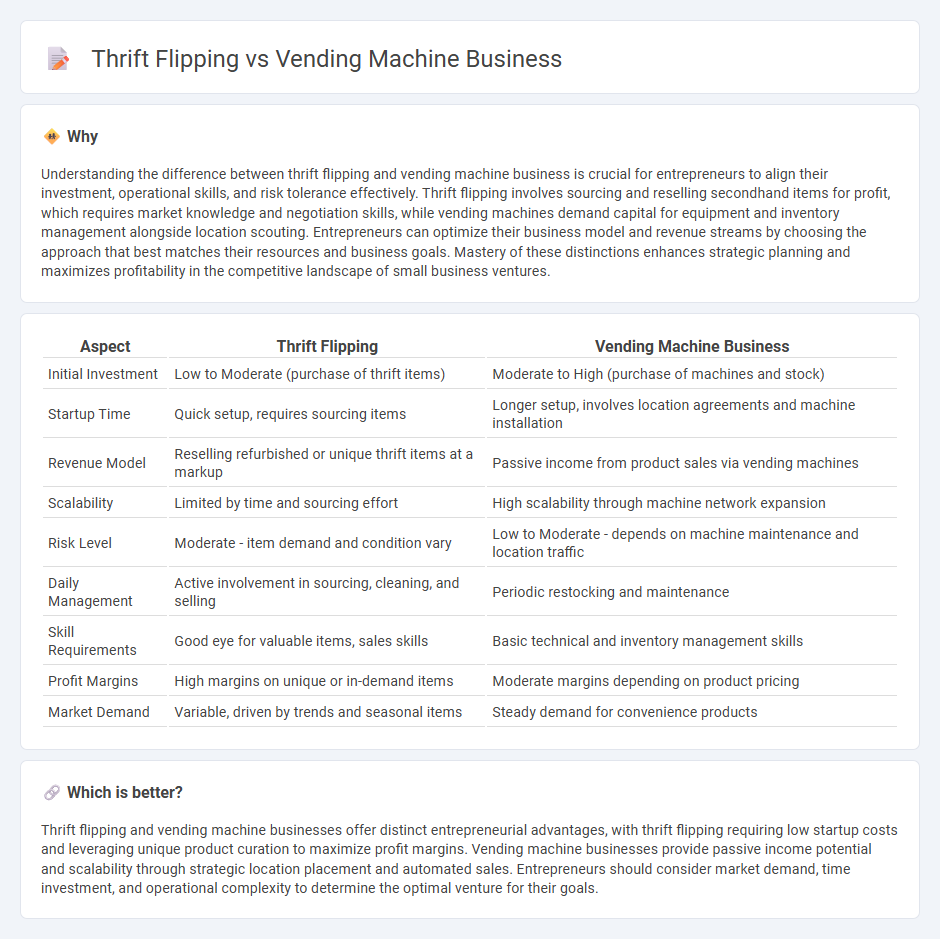
Thrift flipping involves purchasing undervalued items from thrift stores and reselling them online or locally at a profit, capitalizing on keen market knowledge and consumer trends. Vending machine business requires strategic placement and product selection to generate passive income through automated retail, benefiting from consistent foot traffic and minimal daily management. Explore the unique advantages and challenges of each model to identify the best entrepreneurial path for your goals.
Why it is important
Understanding the difference between thrift flipping and vending machine business is crucial for entrepreneurs to align their investment, operational skills, and risk tolerance effectively. Thrift flipping involves sourcing and reselling secondhand items for profit, which requires market knowledge and negotiation skills, while vending machines demand capital for equipment and inventory management alongside location scouting. Entrepreneurs can optimize their business model and revenue streams by choosing the approach that best matches their resources and business goals. Mastery of these distinctions enhances strategic planning and maximizes profitability in the competitive landscape of small business ventures.
Comparison Table
| Aspect | Thrift Flipping | Vending Machine Business |
|---|---|---|
| Initial Investment | Low to Moderate (purchase of thrift items) | Moderate to High (purchase of machines and stock) |
| Startup Time | Quick setup, requires sourcing items | Longer setup, involves location agreements and machine installation |
| Revenue Model | Reselling refurbished or unique thrift items at a markup | Passive income from product sales via vending machines |
| Scalability | Limited by time and sourcing effort | High scalability through machine network expansion |
| Risk Level | Moderate - item demand and condition vary | Low to Moderate - depends on machine maintenance and location traffic |
| Daily Management | Active involvement in sourcing, cleaning, and selling | Periodic restocking and maintenance |
| Skill Requirements | Good eye for valuable items, sales skills | Basic technical and inventory management skills |
| Profit Margins | High margins on unique or in-demand items | Moderate margins depending on product pricing |
| Market Demand | Variable, driven by trends and seasonal items | Steady demand for convenience products |
Which is better?
Thrift flipping and vending machine businesses offer distinct entrepreneurial advantages, with thrift flipping requiring low startup costs and leveraging unique product curation to maximize profit margins. Vending machine businesses provide passive income potential and scalability through strategic location placement and automated sales. Entrepreneurs should consider market demand, time investment, and operational complexity to determine the optimal venture for their goals.
Connection
Thrift flipping and vending machine businesses both capitalize on identifying undervalued assets to generate profit through strategic resale or service delivery. Entrepreneurs leverage thrift flips by purchasing low-cost items and enhancing their value for higher resale, similar to vending machine operators who invest in stocking high-demand products to maximize revenue per machine. Both models require market insight, cost-effective sourcing, and scalability to optimize returns and build sustainable entrepreneurial ventures.
Key Terms
**Vending machine business:**
The vending machine business generates passive income by selling snacks, beverages, and convenience items, requiring upfront investment in machines and strategic placement in high-traffic areas. It benefits from low labor costs and consistent cash flow, with opportunities to scale by adding more machines or diversifying product offerings. Explore how to maximize profits and streamline operations in the vending machine business.
Passive income
Vending machine business generates passive income through automated sales of snacks and beverages, requiring initial investment in machines and location permits but minimal daily effort. Thrift flipping involves buying undervalued second-hand items and reselling them at a profit, which demands active sourcing, pricing knowledge, and occasional reinvestment of time. Explore detailed strategies for maximizing passive income streams in both vending machine operations and thrift flipping ventures.
Inventory management
Vending machine business requires consistent monitoring of stock levels and automated replenishment schedules to avoid downtime and maximize sales efficiency. Thrift flipping depends heavily on curating unique inventory from secondhand sources, demanding careful selection and timing to capitalize on market trends. Explore detailed strategies to optimize inventory management for both ventures to enhance profitability.
Source and External Links
5 Steps for Starting a Vending Machine Business - Starting a vending machine business involves registering the business, selecting products, securing locations, purchasing machines, and managing operations, with low overhead and good profit potential especially if multiple machines are managed strategically.
How to Start a Vending Machine Business - Key steps include market research, product selection, finding high-traffic locations, and adapting to consumer demand, with the vending machine industry showing recent signs of recovery and offering around $300 monthly revenue per machine on average.
How To Start a Vending Machine Business (2024) - To start, conduct market research to evaluate competition and demand, choose suitable products based on that research, set up your business legally, buy machines, find strategic locations, stock inventory, and scale your business over time.
 dowidth.com
dowidth.com